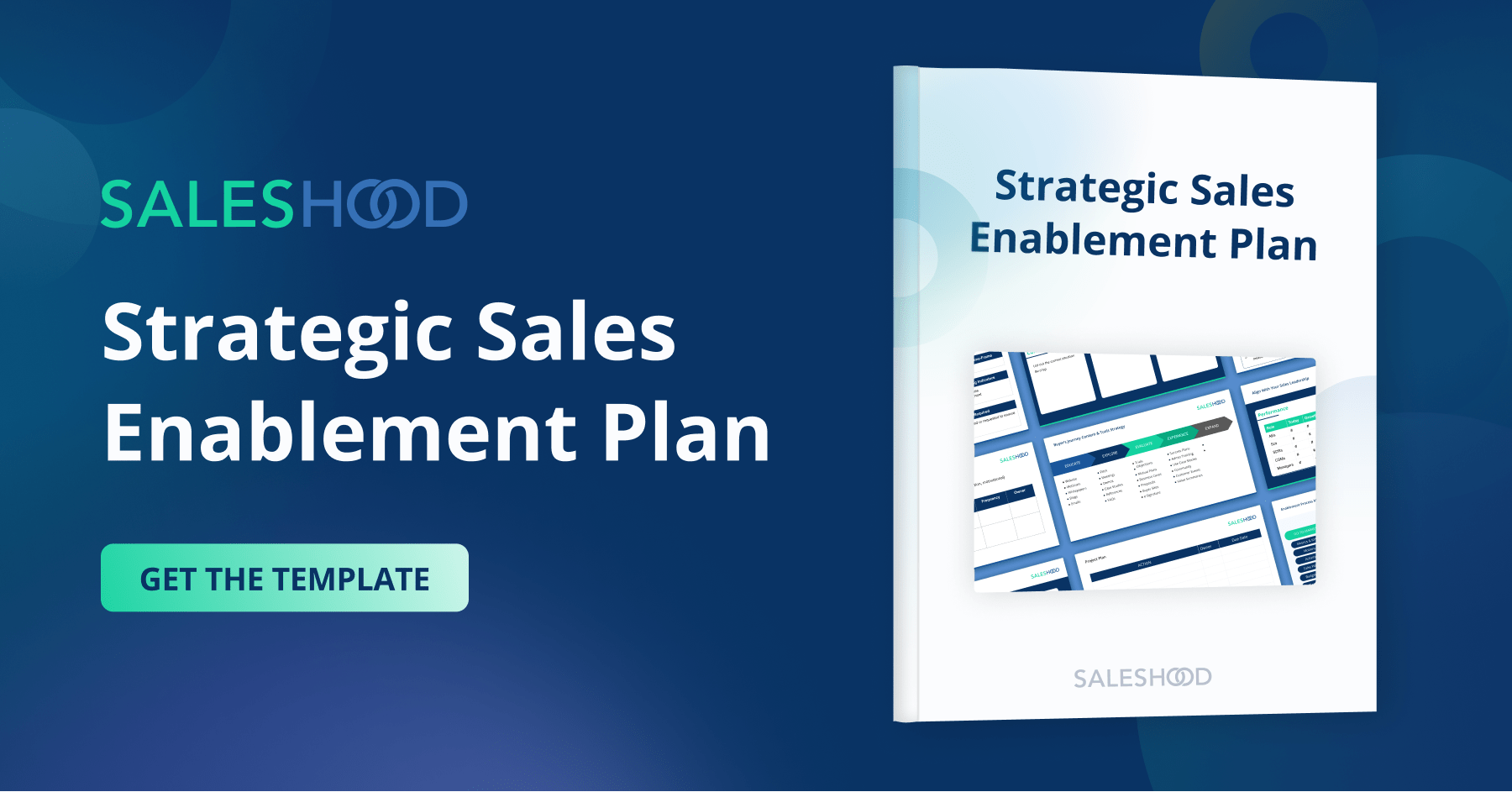In our Sales Enablement with Intent and Impact webinar, Saleshood CEO Elay Cohen and PowerSchool VP of Sales Strategy & Enablement and Chief of Staff Carol Sustala discussed the importance of being intentional to drive sales. Here’s a look at the content discussed during the webinar.
6 Pillars Of Intentional Sales Strategy And Enablement
Sales strategy and enablement can mean a lot of different things in organizations and to executive leadership. It’s up to each sales professional to not just help the company define it, but also be able to pinpoint where you’re going to make the biggest impact. It’s not always obvious.
In this post, I’ll share six different ways you can approach sales enablement with intent, so you can see more sales success in your organization.
- Understanding The Importance Of Being Present
- Building Relationships With Sales And Marketing Leaders
- Getting Ahead Of The Curve—Together
- Being Curious About Data
- Using Key Metrics To Drive Decisions And Investments
- Deploying The Right Tools To Scale
Understanding The Importance Of Being Present
In an era where we always have the next meeting popping up on our calendars or another notification to respond to, attention is fleeting. This is understandable, but distractions damage our ability to be successful in sales enablement.
Being intentional about sales requires you to be present and in the moment with every conversation. You have to stay aware of the discussions you’re in while paying attention to what’s going on in the company and what’s going on in the market. That way, you can listen for and identify opportunities to act on and create impact.
The secret to being able to see the patterns and connect those dots is showing up and giving your full attention. That’s what makes it possible to find those little moments. It empowers you to see where there might be a lever you can apply pressure to that will move your sales strategy forward.
Building Relationships With Sales And Marketing Leaders
While sales enablement has come a long way, there’s still some distance to go to build relationships. There’s so much more that you can do to continue to earn a seat at the table. When you take the right steps, you can move past surface-level relationships and make every interaction more valuable.
It’s important to remember the human being behind the title, and recognize that we’ve all got challenges in our role. We’ve all got audacious goals that we’re trying to attain. Try to be cognizant of those things when building bridges, and try to understand common goals. That way, you can work together to accomplish them and you truly act as a team.
Planning my calls plays a key role in effective and intentional sales enablement. I have all of my meetings color-coded and I can look at my calendar for a week or a month at a glance. It quickly tells me if I’m spending too much time within my team, and I’m not as outwardly focused as I need to be. It can also show me that I’m doing a great job within the sales organization but I’m not investing enough proactive time with departments like services, customer success, or marketing.
When I take calls, even if we don’t have something specific to talk about because we communicate frequently, we still make the connection. Instead of saying: “Let’s get that time back,” we ask how it’s going. When you do this, you’ll often uncover a hidden gem. You’re going past the to-do list and instead investing the time in building relationships with your people.
Getting Ahead Of The Curve—Together
The environment around us is always changing, and our sales strategy must evolve with it. That’s why it’s so important to keep everyone on the same page and give people a forum where they can come to learn.
At Powerschool, we do office hours together. Sales knows at any point, you can dial into office hours and ask a quick question. Everyone on the team can get the answers they need and we can address any knowledge gaps. When you align your people, you get the results that you want.
In addition, what this allows me to do is gain greater understanding, step back from the right now and know that things are in capable hands from a sales enablement perspective. I can focus on the bigger picture.
When I’m looking towards the future, I’m thinking about our sales organization in terms of the group we have today and the new talent we’re bringing in. What are we doing with them to elevate their capabilities today and tomorrow? How are we attracting the new talent that we need to grow? These are the initiatives I can put more of my time and energy into when I know that we have a foundation in place where everyone can get the help they’re looking for.
Being Curious About Data
How do you combine being intentional with sales strategy, curiosity around data, and monitoring KPIs? Keeping a close eye on how the data shows what’s happening both externally and internally with your people is critical.
For example, at PowerSchool, we look at transaction size for each of our customer segments with our new hires. After that, we look for reps that are getting caught in their comfort zone where we’re not seeing them hit above the watermark in terms of their sales performance. Then, we can dig a little deeper into what’s behind those trends to find ways to better support our reps.
In contrast, your data can also tell you when what you’re doing is serving the organization well. When we look at Powerschool data, we can actually see that our 2020 hires outperformed hires from the previous year in every metric related to the business. While there are always areas for improvement, this is a clear indicator that we’re making the right decisions when it comes to hiring and nurturing new talent.
Using Key Metrics To Drive Decisions And Investments
Once you begin to understand what areas you can improve on, you can take action by making business decisions that move the needle. If you aren’t seeing members of your sales team meet your expectations for performance, you can do more research to see what they really need.
One of the questions that we include in our surveys about training is the relevance to the job. We want to know if the training we’re providing gives our reps more confidence in their roles. If the confidence is not there, that tells us people need more practice. If the competence is not there, we know that we have to provide more sales strategy training. This is an indicator to find ways to elevate understanding.
Beyond that, for every single team and for every line of business, we drill in and see what our pipeline coverage looks like and what we’re forecasting. This way, we can see what areas might need more support, and we can also look for opportunities to better meet the needs of our customers.
Deploying The Right Tools To Scale
Building your tech stack to support the sales strategy in your organization also plays a key role. Choosing the right tools to drive prospecting, see into your pipeline, and track results can help you find out where things may be slipping through the cracks. It also empowers your sales leaders, as they can easily find the information that’s important to them.
Further, when you build your tech stack, you should be aware of how you can connect all these different sources of data together. Each tool you select may be powerful on its own but the true power is in being able to see patterns. Being intentional about uncovering them will only get you so far. When you can leverage technology in a way that supports this goal, it becomes much easier for you to achieve.
Intention, Sales Enablement, And Sales Strategy: Bringing It All Together
Bringing intention into the way you approach sales can transform your team’s performance, but to make this an effective part of your sales strategy, you have to focus on the right things. As you begin to implement this for your organization, there are a few things to remember.
First, on any given day, understand where you can have the biggest impact and make sure your calendar has space for those calls, so you can be present. Next, take note of what metrics the executive team cares about and what’s important to the company. Ask questions to gain clarity on the importance of those metrics and figure out how they align.
Finally, be curious. Not just about data, but about what’s on the mind of your sales managers and their reps. All these things will help you determine what actions to take to make your numbers.
More sales enablement resources
15 Sales Enablement Leaders You Should Know
Sales Enablement Leadership Course



